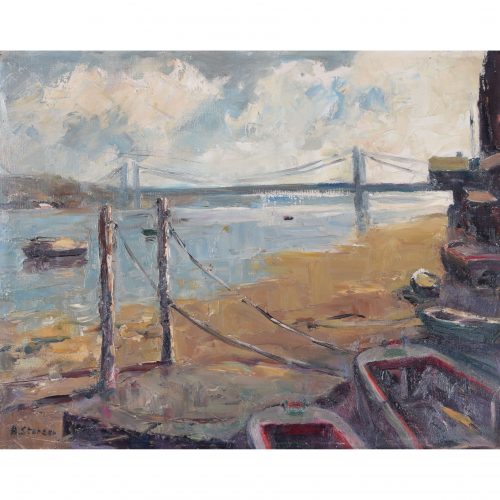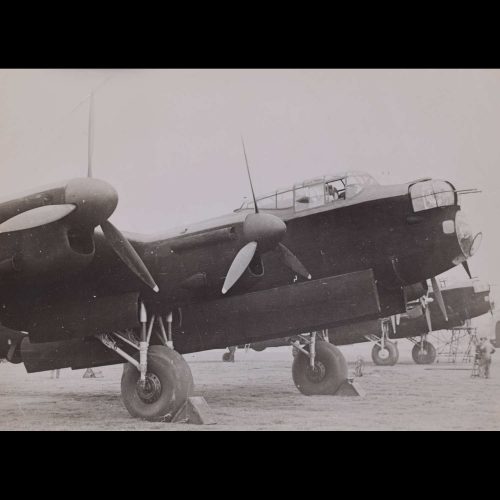-
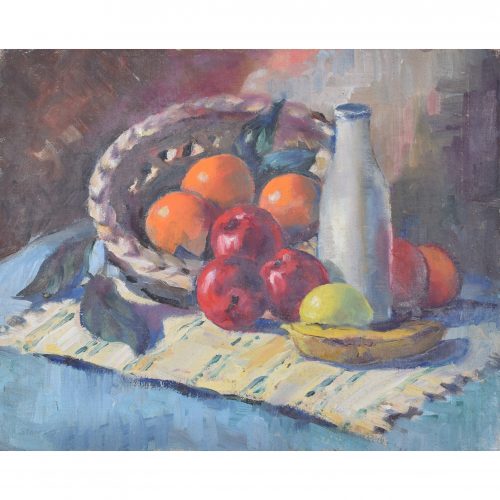
Angela Stones (1914 - 1995)
Still Life with Fruit and Milk Bottle
Oil on board 41 x 51 cm Signed lower left. A mid-century still life in oils, characterised by Stones' textured brushwork and use of vivid colours. Stones was educated at the Chelsea School of Art, and was a member of an artistic dynasty. Her mother Dorothy Bradshaw (1893-1983) studied under Jack Merriott – the artist famous for his British Rail posters, and her son, Christopher Assheton-Stones (1947-1999), was arguably the foremost pastel artist of his time. Provenance: the family of the artist. Condition: very good. If you’d like to know more, please email info@manningfineart.co.uk or call us on 07929 749056. -

Angela Stones (1914 - 1995)
Irises
Oil on board 56 x 41 cm Signed lower right. A glass jar of irises, with two shells, on a pale pink and peach backdrop. Stones'' impasto technique brings texture to the shells and petals, and shades of purple offset the greens and pinks of the composition. Stones was educated at the Chelsea School of Art, and was a member of an artistic dynasty. Her mother Dorothy Bradshaw (1893-1983) studied under Jack Merriott – the artist famous for his British Rail posters, and her son, Christopher Assheton-Stones (1947-1999), was arguably the foremost pastel artist of his time. Provenance: the family of the artist. Condition: very good. If you’d like to know more, please email info@manningfineart.co.uk or call us on 07929 749056. -
Out of stock
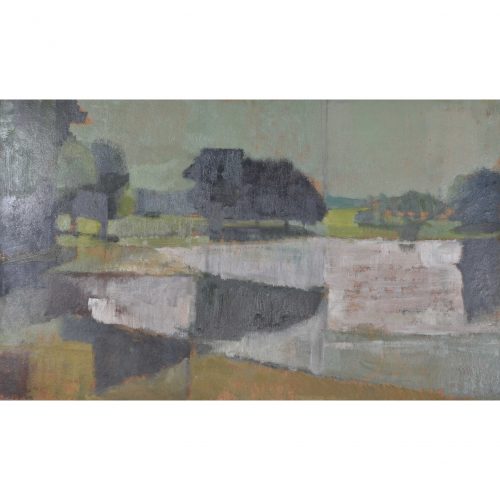
Bernard Myers (1925 - 2007)
South London Park
Oil on board 38 x 64 cm Myers' abstract oil of a London park. Blocks of colour make up the forms of the landscape, textured by the artist's thick, lateral brushstrokes. Bernard Myers was a painter and printmaker who trained at St Martin’s School of Art, the Camberwell School of Arts and Crafts, and the Royal College of Art in the 1940s and 1950s. This painting won the David Murray Landscape Scholarship and was painted while Myers was a student at the RCA. He went on to teach there before moving into a studio in Hammersmith. Condition: very good. Recently cleaned and revarnished. If you’d like to know more, please email info@manningfineart.co.uk or call us on 07929 749056. -
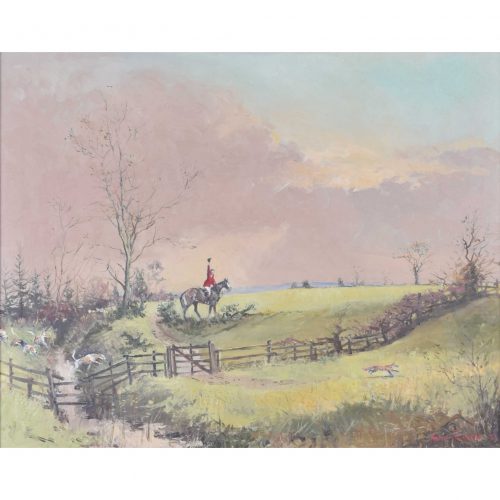
Robin Furness (born 1933)
The Three O'Clock Fox - Dobinson's Covert (1972)
Oil on canvas 40 x 50 cm Signed lower right. A delightful oil painting of the Raby Hunt at Bedburn by Robin Furness, former MFH of the Bedale Hunt and noted painter of hunting scenes. Condition: very good. If you’d like to know more, please email info@manningfineart.co.uk or call us on 07929 749056. -
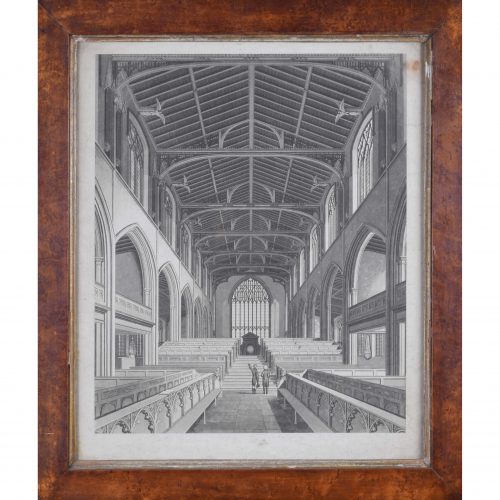
Chapel Interior (circa 1800)
Engraving 49 x 40 cm An engraving of a magnificent chapel interior. Two men tour the chapel, one gesticulating towards the spectacular design of the chancel window. Condition: good. Some gentle discolouration; in faux burr-maple frame. If you’d like to know more, please email info@manningfineart.co.uk or call us on 07929 749056. -
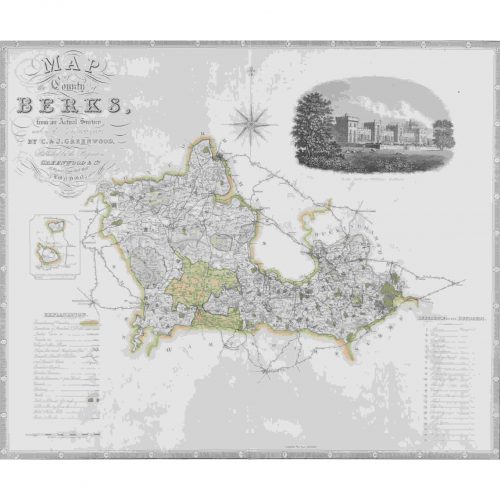
John Dower (1825 - 1901)
Map of Berkshire from an actual survey made in the years 1822 & 1823
Engraving 57 x 69 cm A large antique engraved map of Berkshire. Condition: good; some light staining. If you’d like to know more, please email info@manningfineart.co.uk or call us on 07929 749056. -
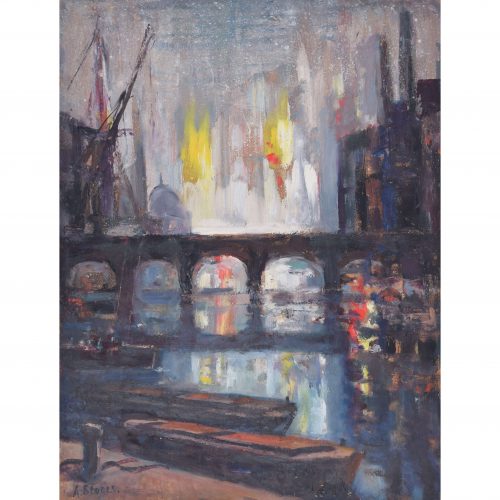
Angela Stones (1914 - 1995)
Old London Bridge Fantasia (1968)
Oil on board 56 x 43 cm Signed lower left. A fantasia inspired by Old London Bridge on the Thames. The grey dome of St Paul's peeps over the bridge; bright lights burn in the background, throwing yellows and red reflections onto the water. Moored boats bob gently in the foreground. Stones was educated at the Chelsea School of Art, and was a member of an artistic dynasty. Her mother Dorothy Bradshaw (1893-1983) studied under Jack Merriott – the artist famous for his British Rail posters, and her son, Christopher Assheton-Stones (1947-1999), was arguably the foremost pastel artist of his time. Provenance: the family of the artist. Condition: very good. If you’d like to know more, please email info@manningfineart.co.uk or call us on 07929 749056. -
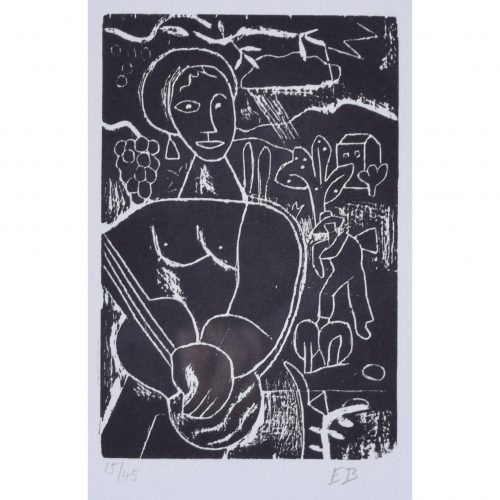
Edward Burra (1905 - 1976)
The Guitar Player
(1928 - 1929, this edition published 1971) Woodcut 15 x 10 cm; sheet size 34 x 24 cm Numbered 15/45 lower left and initialled EB lower right. Burra's woodcut of a female guitar player surrounded by a landscape of cacti. A bunch of grapes is pendent beside her triangular earring, and a male figure in a wide-brimmed hats stands in the field nearby. Edward Burra was an English painter, draughtsman, and printmaker. He travelled to Italy in 1925, the same year he met the noted British Surrealist Paul Nash, and both of these influences are evident in this woodcut. Nash introduced Burra to woodcut-making in 1928, the same year that Burra began this woodcut series. His first solo show was held at the Leicester Galleries in April 1929, and he exhibited with the English Surrealists in the 1930s. Condition: Excellent. If you’d like to know more, please email info@manningfineart.co.uk or call us on 07929 749056. -
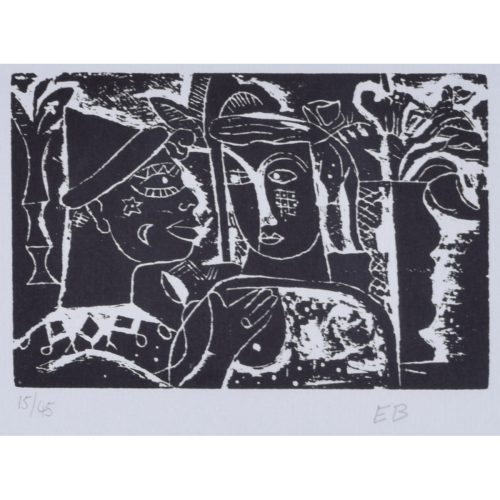
Edward Burra (1905 - 1976)
Café
(1928 - 1929, this edition published 1971) Woodcut 10 x 15 cm; sheet size 24 x 34 cm Numbered 15/45 lower left and initialled EB lower right. Published by the Nicholas Treadwell Gallery in 1971. Burra's woodcut of a male and a female figure, entitled 'Café'. The two figures, seemingly a couple, gaze at one another intensely and intimately, giving the impression of having been interrupted by the viewer. Both figures' faces bear tattoo-like markings: he a star and the moon, she a geometric design resembling a noughts-and-crosses board. The "café" in which they sit is a dreamily abstract landscape full of palms and other plants from the tropics. Edward Burra was an English painter, draughtsman, and printmaker. He travelled to Italy in 1925, the same year he met the noted British Surrealist Paul Nash, and both of these influences are evident in this woodcut. Nash introduced Burra to woodcut-making in 1928, the same year that Burra began this woodcut series. His first solo show was held at the Leicester Galleries in April 1929, and he exhibited with the English Surrealists in the 1930s. Condition: Excellent. If you’d like to know more, please email info@manningfineart.co.uk or call us on 07929 749056. -
Out of stock
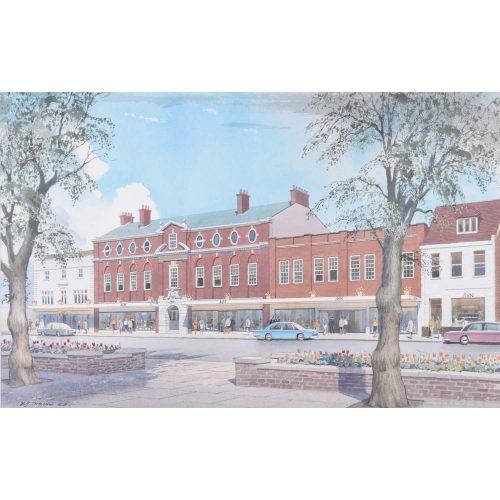
Edmund J Thring (1906-1985)
Architectural Perspective Design for a Building in Salisbury
38 x 60 cm Watercolour / gouache Framed. We are informed that the building still exists on Chichester High Street, though in slightly different form from the way it is painted here. Click here for other works by Thring. -
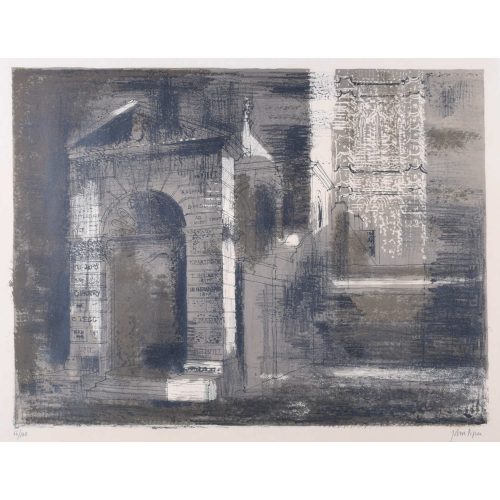
John Piper (1903-1992)
Westminster School I (1961)
49 x 63 cm Signed lower right and numbered 66/100 lower left in pencil. Piper's skilled and characterful rendering of Westminster School's gateway, sometimes known as Burlington's Arch. The historic entrance to the school dates from 1734 and is carved with the names of former pupils. John Piper CH was an English painter, printmaker, and designer of stained-glass windows. His work often focused on the British landscape, especially churches and monuments, and included tapestry designs, book jackets, screen-prints, photography, fabrics and ceramics. Condition: Generally very good, gentle even toning to the paper. If you’d like to know more, please email info@manningfineart.co.uk or call us on 07929 749056. -
Out of stock
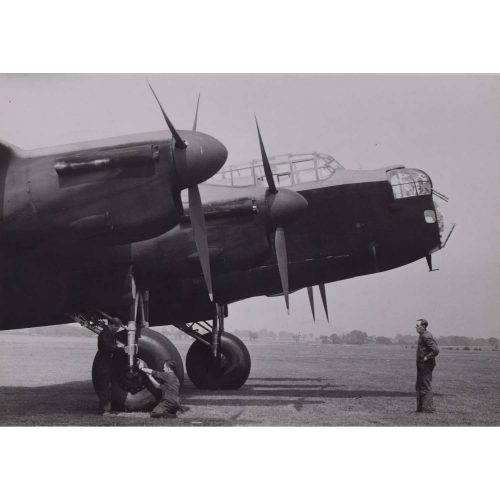
Lancaster Bomber
Original Silver Gelatin photograph, July 1942 11 x 16 cm Stamped to reverse 'Passed for Publication 2 July 1942 Press and Censorship Bureau', 'Public Relations Branch MAP'. A fine photograph; two erks are adjusting the starboard undercarriage of a Lancaster bomber whilst being supervised - the supervisor apparently with his hands in his pockets in very unmilitary fashion! The sun is high in the sky, casting a rather fine shadow under the bomber. -
Out of stock
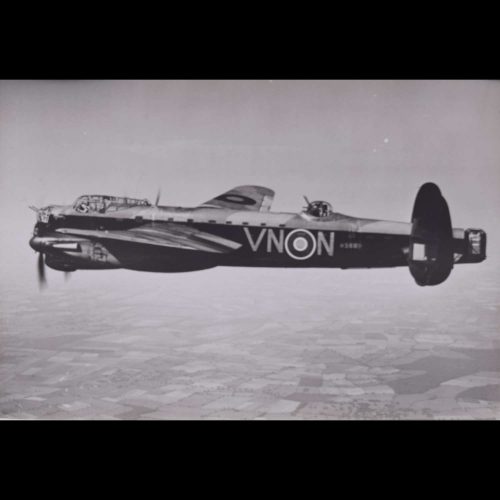
Lancaster Bomber VN-N R5689
Original Silver Gelatin photograph 11 x 16 cm Stamped to reverse 'This TP Copyright illustration from 'The Aeroplane' must not be reproduced without the written permission of Temple Press.' The photograph - and several others of the Swinderby based R5689 of 50 Sqn - was taken on 28 August 1942. The pilot was Sqn Ldr Hugh Everitt. One of the most photographed Lancasters of the RAF's fleet, it was utilised for literature that trained aircrew to recognise the Lancaster. It is also proposed that it be imortalised by the Bomber Gateway Trust with a lifesize replica spraying poppies across the country, just a short distance from its crash site in Lincolnshire. Further funding is required before the project can be completed. R5689 was destroyed on the night of 18/19 September that year. It had been on a sea mining mission and crashed on landing when both port engines failed. Four crew members were killed and three further were injured. Everitt was not flying R5689 on the night it crashed. He survived the war - having flown 56 operations for which he was decorated three times, commanded a V-bomber squadron and played golf into his nineties. He died in 2012 and the Telegraph published an obituary. We have another photograph that includes him sitting on the grass in front of a Lancaster that is being armed. -
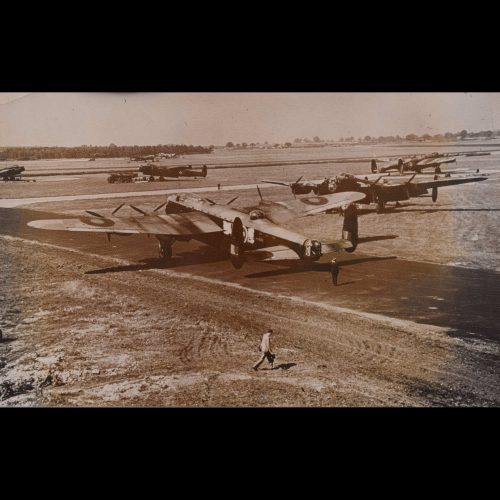
Lancaster Bomber VN-N R5689
Original Silver Gelatin photograph 11 x 16 cm Stamped to reverse 'This TP Copyright illustration from 'The Aeroplane' must not be reproduced without the written permission of Temple Press.' The photograph - and several others of the Swinderby based R5689 of 50 Sqn - was taken on the base open day in June 1942, a week or so after the aerodrome had reopened having been improved with concrete - rather than grass - runways. R5689 was destroyed on the night of 18/19 September that year. It had been on a sea mining mission and crashed on landing when both port engines failed. Four crew members were killed and three further were injured. It is also proposed that R5689 be imortalised by the Bomber Gateway Trust with a lifesize replica spraying poppies across the country, just a short distance from its crash site in Lincolnshire. Further funding is required before the project can be completed. They have 'colourised' a copy of this photograph on their website, see here. Condition: the photograph has discoloured and taken on a sepia hue as may be seen in the image. Provenance: from the collection of Philip J R Moyes, author of many books on the RAF, most notably The Pictorial History which ran to several volumes. -
Out of stock
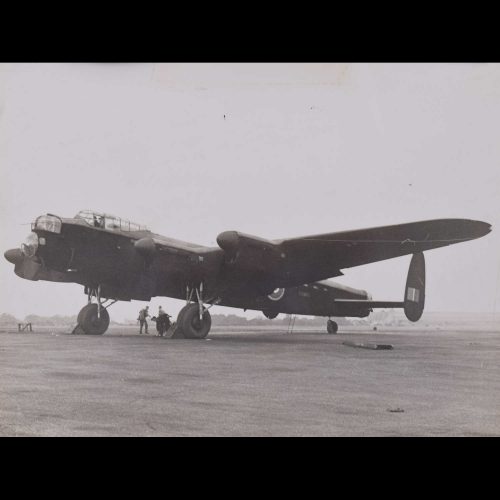
Lancaster Bomber at RAF Waddington
Original Silver Gelatin photograph 16 x 22 cm Stamped to reverse 'Passed by censor' and 'Copyright This photograph must not be reproduced without permission of 'The Aeroplane.' Unfortunately the serial number of the aeroplane is unclear. It may be RAF Waddington-based R5905 of 44 Sqn which crash landed near Madum in Denmark on 24 September 1942. The crew all survived the landing and were taken prisoner, spending the rest of the war in a PoW camp (where one died in March 1945) before returning home. Further details regarding their exploits are here. Alternatively it is R5903 also of 44 Sqn which crashed at Klosterholte on 7 October 1942 having left RAF Waddington; five of the crew survived the crash, with the two airgunners dying. -
Out of stock
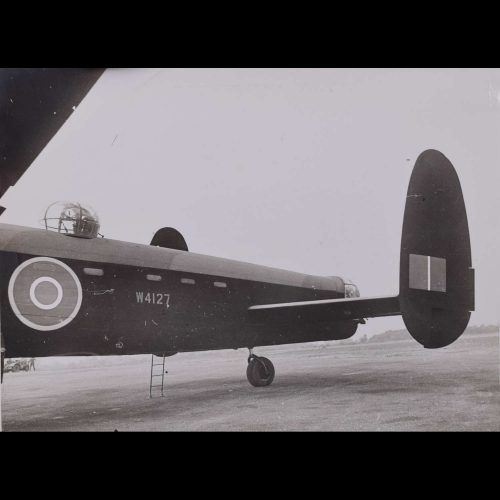
Lancaster Bomber W4127
Original Silver Gelatin photograph 16 x 21 cm Stamped to reverse 'Copyright this photograph must not be reproduced without the written permission of The Aeroplane.' W4127, of Sqn 419 (RCAF) was lost on the night of 20/21 April 1944 whilst returning from a mission to bomb the railway yards at La Chappelle. Having taken off from Dunholme Lodge at 22.07 and completed its bombing raid, it was attacked by a night fighter, suffering a fire in one wing, crashing north of Paris. The yards were badly damaged by the bombing, the mission a success. Six of the crew were killed and are buried in Poix de la Somme churchyard, whilst one, Bob Hortie, evaded escape. The Comet line - the escape line that took downed airmen to Spain whereby they could return to England - found it hard to operate with the destruction of rail and road infrastructure in the period leading up to D-Day and the invasion of Europe. Airey Neave of MI9 therefore set up three camps in isolated forests in Northern France where downed airmen could await the invading allied forces. The camps were supplied - and manned - by the allies through parachute drops. Hortie was one of 152 allied airmen to be in the camp at Fréteval - codenamed 'Sherwood Camp'. Neave went to France in the middle of August, to Le Mans which was controlled by the Americans and was 75 miles from Sherwood Camp. The Americans distrusted Neave and refused to provide him with transport. He managed to come up with some trucks and buses, which - decked out with flowers and French flags and guarded by a civilians armed with rifles and a handful of SAS men - set out to Fréteval on 14 August 1944 returning the same day with 132 airmen. A further 20 were recovered the following day. Most returned to active service and 38 died before the end of the war. A souvenir from the camp is published here on the internet. The camps were due to be set up by a team that included Belgian resistance member Michelle Dumon, who at the age of 22 (with an identity card that showed she was 16) had exfiltrated 250 airmen by this point. However she unmasked a German infiltrator into the Comet line just as the camps were being set up and was therefore sought by the Gestapo and had to flee to England. That seemingly simple journey of course meant a perilous journey across France to Spain, crossing the Pyrenees on foot, and being rescued by the RAF. In this photograph L4127 is without its squadron letters, suggesting that it is fresh out of the factory at the time of the photograph. -

Lancaster Bomber with 8000lb cookie bomb
Original Silver Gelatin photograph, September 1943 19 x 25 cm Stamped to reverse 'Copyright this photograph must not be reproduced without the written permission of The Aeroplane.' BRITISH OFFICIAL PHOTOGRAPH CH 10939(WK) Air Ministry Photo- Crown Copyright Reserved (Picture issued September 1943) THE RAF's EIGHT THOUSAND POUND BOMB Stamped to reverse 'British Official Photograph, Crown Copyright Reserved, Supplied by BIPPA, Passed for publication by Ministry of Information'. The press release states: First official photographs of the RAF's 8,000 lb and 4,000 lb bombs are now released. Their weight has been felt with devastating effect on enemy targets in Italy and Germany. Picture shows:- Close-up of an 8,000 lb bomb in front of the Lancaster which will carry it on the night's raid. The 8000 lb 'super cookie' was a 'blockbuster' bomb, so-called because it could destroy an entire block of flats on its own. The Germans called these large bombs 'Luftminen' - airmines - as during the Blitz the large bombs used by the Luftwaffe were adapted marine mines. Judging by the length of the hair of the person sitting by the bomb, this is a member of the WAAF. WAAFs were often used to drive tractors on aerodromes during the war. Condition: generally good Provenance: from the collection of Philip J R Moyes, author of many books on the RAF, most notably The Pictorial History which ran to several volumes. -
Out of stock
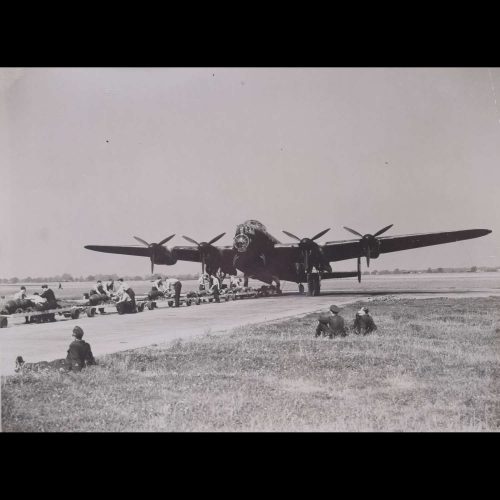
Lancaster Bomber being armed
Original Silver Gelatin photograph, c. 1942 16 x 21 cm Stamped to reverse 'Copyright this photograph must not be reproduced without the permission of Aeroplane' and 'This photograph has been passed by censor'. The photograph of the Swinderby based 50 Sqn - was taken in 1942. Either at the June reopening of the aerodrome with its new concrete runways (replacing grass) or in August when the photographers descended on the aerodrome again to take photographs for aircraft recognition purposes. Everitt survived the war - having flown 56 operations for which he was decorated three times, subsequently he was a bombing instructor, commanded a V-bomber squadron, and played golf into his nineties. He died in 2012 and the Telegraph published an excellent obituary. Provenance: from the collection of Philip J R Moyes, author of many books on the RAF, most notably The Pictorial History which ran to several volumes. -
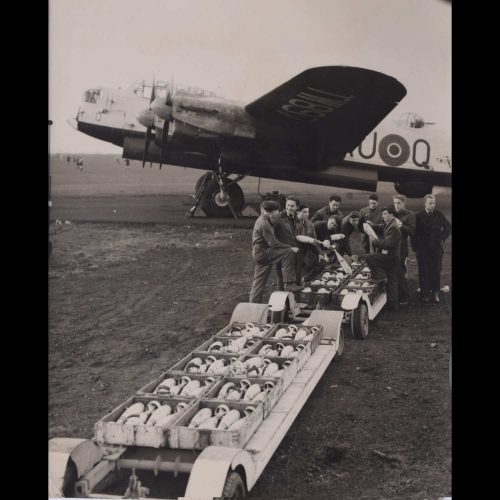
Lancaster Bomber AU-Q loading bombs
Original Silver Gelatin photograph 25 x 20 cm Stamped to reverse 'Copyright Associated Press Photograph' Press release states:LAST MINUTE PREPARATIONS FOR TOMORROW'S ATTACK ON THE FLEET At RAF Station Upwood, Hunts, today, Dec 8th last minute preparations were being carried out for tomorrow's attack on the fleet. Photo shows airmen of 148 Squadron no 3 Bomber Command look over smoke bombs with a Lancaster in background. WOR 339888 Provenance: from the collection of Philip J R Moyes, author of many books on the RAF, most notably The Pictorial History which ran to several volumes. Condition: generally good. -
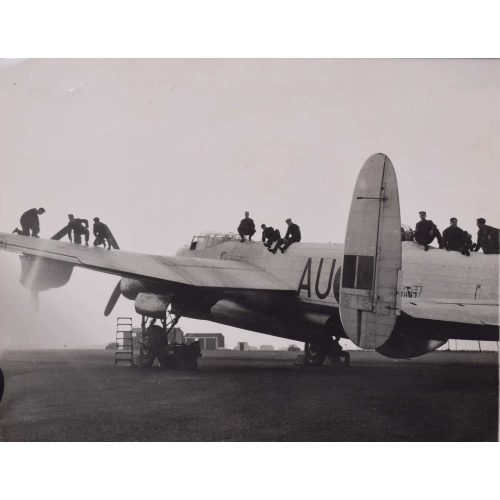
Lancaster Bomber AU-Q loading bombs
Original Silver Gelatin photograph 21 x 25 cm Stamped to reverse 'Copyright Associated Press Photograph' Press release states:LAST MINUTE PREPARATIONS FOR TOMORROW'S ATTACK ON THE FLEET At RAF Station Upwood, Hunts, today, Dec 8th last minute preparations were being carried out for tomorrow's attack on the fleet. Photo shows a Lancaster being made ready for a dawn take off tomorrow photographed this evening against the setting sun. WOR 339889 Associated Press Photo Provenance: from the collection of Philip J R Moyes, author of many books on the RAF, most notably The Pictorial History which ran to several volumes. -
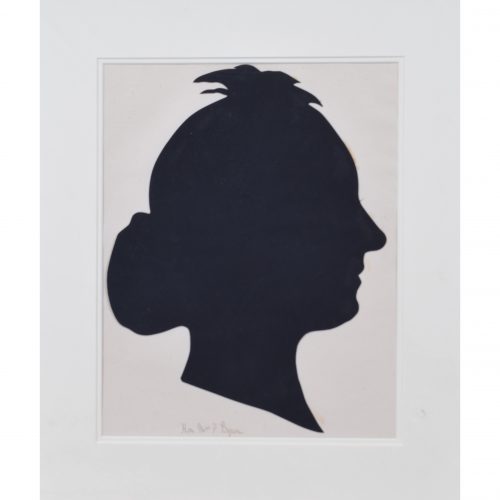
Silhouette (circa 1870)
The Hon Mrs F Byron
Gouache, pen, and ink 52 x 44 cm Likely Mary Jane Wescomb, the daughter of the daughter of Reverend William Wescomb. She married the Hon Frederick Byron in 1851; Byron was a cricketer educated at Westminster and Balliol College, Oxford, and became a fellow at All Souls College in 1843. The couple moved in to Langford Grove together after their marriage. Prior to photography, silhouettes were the easiest way of recording a person's appearance. This set might record the group present at a country house party, a wedding, or other similar convivial occasion. Condition: generally very good. If you’d like to know more, please email info@manningfineart.co.uk or call us on 07929 749056. -
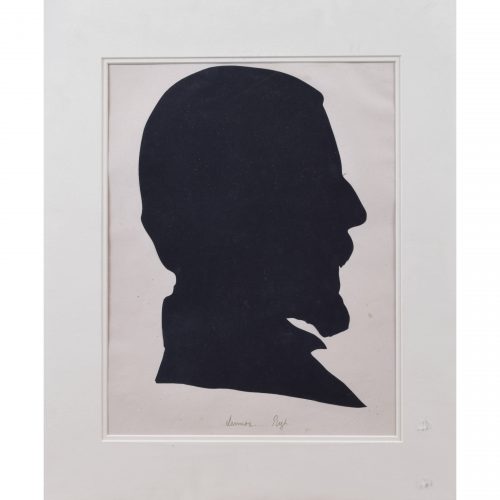
Silhouette (circa 1870)
Lennox
Gouache, pen, and ink 52 x 44 cm Prior to photography, silhouettes were the easiest way of recording a person's appearance. This set might record the group present at a country house party, a wedding, or other similar convivial occasion. Condition: generally very good. If you’d like to know more, please email info@manningfineart.co.uk or call us on 07929 749056. -
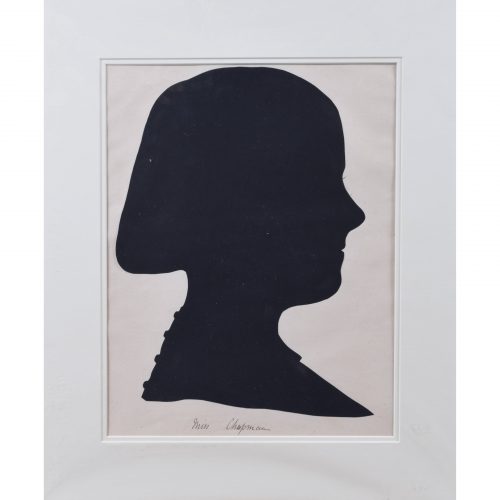
Silhouette (circa 1870)
Miss Chapman
Gouache, pen, and ink 52 x 44 cm One of the daughters of David Barclay Chapman - either Ella Maria or Eugenia Susannah. His other daughter, Adeline Mary, appears in another silhouette from this particular set. David Barclay Chapman was a partner in the bank which in 1896 became the Limited Company Barclay & Co, known today as Barclay's. Prior to photography, silhouettes were the easiest way of recording a person's appearance. This set might record the group present at a country house party, a wedding, or other similar convivial occasion. Condition: generally very good. If you’d like to know more, please email info@manningfineart.co.uk or call us on 07929 749056. -
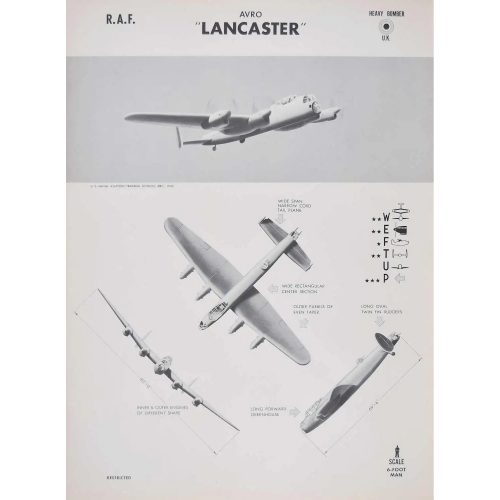
US Naval Aviation Training Division
Avro Lancaster
Aeroplane identification poster, published 1942 63 x 47 cm A particularly unusual style of aeroplane identification poster, owing to the very arty images. Most such posters rely on very plain silhouettes, this series - and we have several in this series; view them here - have a much more arty approach to the task with shading and an interesting angle view. The Avro Lancaster is a British Second World War heavy bomber. It was designed and manufactured by Avro as a contemporary of the Handley Page Halifax, both bombers having been developed to the same specification, as well as the Short Stirling, all three aircraft being four-engined heavy bombers adopted by the Royal Air Force (RAF) during the same wartime era. The Lancaster has its origins in the twin-engine Avro Manchester which had been developed during the late 1930s in response to the Air Ministry Specification P.13/36 for a capable medium bomber for "world-wide use". Originally developed as an evolution of the Manchester (which had proved troublesome in service and was retired in 1942), the Lancaster was designed by Roy Chadwick and powered by four Rolls-Royce Merlins and in one version, Bristol Hercules engines. It first saw service with RAF Bomber Command in 1942 and as the strategic bombing offensive over Europe gathered momentum, it was the main aircraft for the night-time bombing campaigns that followed. As increasing numbers of the type were produced, it became the principal heavy bomber used by the RAF, the Royal Canadian Air Force (RCAF) and squadrons from other Commonwealth and European countries serving within the RAF, overshadowing the Halifax and Stirling. A long, unobstructed bomb bay meant that the Lancaster could take the largest bombs used by the RAF, including the 4,000 lb (1,800 kg), 8,000 lb (3,600 kg) and 12,000 lb (5,400 kg) blockbusters, loads often supplemented with smaller bombs or incendiaries. The "Lanc", as it was known colloquially, became one of the most heavily used of the Second World War night bombers, "delivering 608,612 long tonnes of bombs in 156,000 sorties". The versatility of the Lancaster was such that it was chosen to equip 617 Squadron and was modified to carry the Upkeep "bouncing bomb" designed by Barnes Wallis for Operation Chastise, the attack on German Ruhr valley dams. Although the Lancaster was primarily a night bomber, it excelled in many other roles, including daylight precision bombing, for which some Lancasters were adapted to carry the 12,000 lb (5,400 kg) Tallboy and then the 22,000 lb (10,000 kg) Grand Slam earthquake bombs (also designed by Wallis). This was the largest payload of any bomber in the war. In 1943, a Lancaster was converted to become an engine test bed for the Metropolitan-Vickers F.2 turbojet. Lancasters were later used to test other engines, including the Armstrong Siddeley Mamba and Rolls-Royce Dart turboprops and the Avro Canada Orenda and STAL Dovern turbojets. Postwar, the Lancaster was supplanted as the main strategic bomber of the RAF by the Avro Lincoln, a larger version of the Lancaster. The Lancaster took on the role of long range anti-submarine patrol aircraft (later supplanted by the Avro Shackleton) and air-sea rescue. It was also used for photo-reconnaissance and aerial mapping, as a flying tanker for aerial refuelling and as the Avro Lancastrian, a long-range, high-speed, transatlantic passenger and postal delivery airliner. In March 1946, a Lancastrian of BSAA flew the first scheduled flight from the new London Heathrow Airport. Condition: generally very good, occasional handling marks. If you are interested, please email info@manningfineart.co.uk or call us on 07929 749056. -
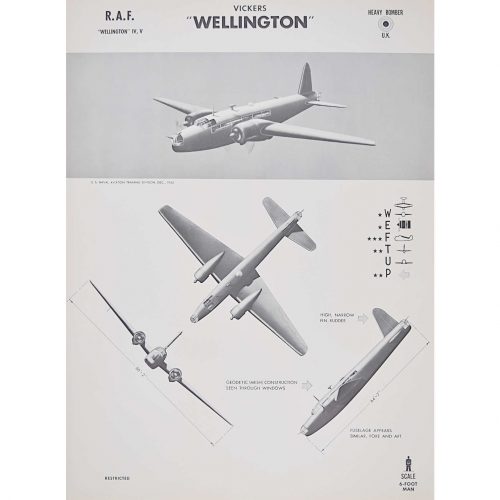
US Naval Aviation Training Division
Vickers Wellington
Aeroplane identification poster, 1942 63 x 47 cm A particularly unusual style of aeroplane identification poster, owing to the very arty images. Most such posters rely on very plain silhouettes, this series - and we have several in this series; view them here - have a much more arty approach to the task with shading and an interesting angle view. The Vickers Wellington was a British twin-engined, long-range medium bomber. It was designed during the mid-1930s at Brooklands in Weybridge, Surrey. Led by Vickers-Armstrongs' chief designer Rex Pierson; a key feature of the aircraft is its geodetic airframe fuselage structure, which was principally designed by Barnes Wallis. Development had been started in response to Air Ministry Specification B.9/32, issued in the middle of 1932, for a bomber for the Royal Air Force. This specification called for a twin-engined day bomber capable of delivering higher performance than any previous design. Other aircraft developed to the same specification include the Armstrong Whitworth Whitley and the Handley Page Hampden. During the development process, performance requirements such as for the tare weight changed substantially, and the engine used was not the one originally intended. The Wellington was used as a night bomber in the early years of the Second World War, performing as one of the principal bombers used by Bomber Command. During 1943, it started to be superseded as a bomber by the larger four-engined "heavies" such as the Avro Lancaster. The Wellington continued to serve throughout the war in other duties, particularly as an anti-submarine aircraft. It holds the distinction of having been the only British bomber that was produced for the duration of the war, and of having been produced in a greater quantity than any other British-built bomber. The Wellington remained as first-line equipment when the war ended, although it had been increasingly relegated to secondary roles. The Wellington was one of two bombers named after Arthur Wellesley, 1st Duke of Wellington, the other being the Vickers Wellesley. A larger heavy bomber aircraft designed to Specification B.1/35, the Vickers Warwick, was developed in parallel with the Wellington; the two aircraft shared around 85% of their structural components. Many elements of the Wellington were also re-used in a civil derivative, the Vickers VC.1 Viking. If you are interested, please email info@manningfineart.co.uk or call us on 07929 749056. -
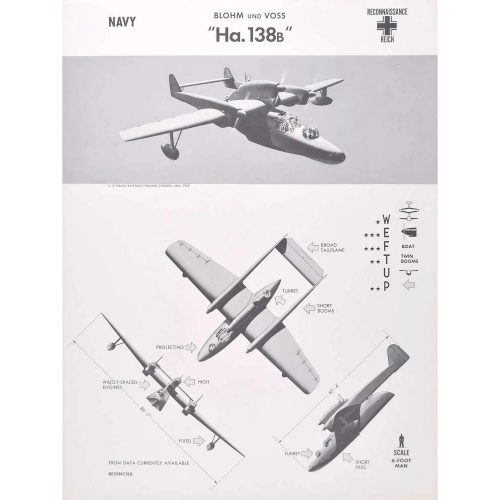
1943 Blohm und Voss "Ha. 138B"
World War II German Reich reconnaissance plane Original aeroplane recognition poster (1943) 63 x 47 cm A particularly unusual style of aeroplane identification poster, owing to the very arty images. Most such posters rely on very plain silhouettes, this series - and we have several in this series; view them here - have a much more arty approach to the task with shading and an interesting angle view. Condition: generally very good, occasional handling marks. If you’d like to know more, please email info@manningfineart.co.uk or call us on 07929 749056. -
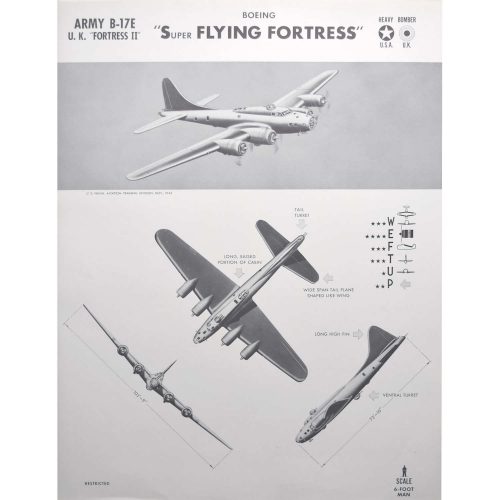
B-17E Boeing "Super Flying Fortress"
World War II US and UK heavy bomber plane Original aeroplane recognition poster (1942) 63 x 47 cm A particularly unusual style of aeroplane identification poster, owing to the very arty images. Most such posters rely on very plain silhouettes, this series - and we have several in this series; view them here - have a much more arty approach to the task with shading and an interesting angle view. The Boeing B-17 Flying Fortress is a four-engined heavy bomber developed in the 1930s for the United States Army Air Corps. From its introduction in 1938, the B-17 Flying Fortress evolved through numerous design advances, becoming the third-most produced bomber of all time. The B-17 was primarily employed by the United States Army Air Forces in the daylight strategic bombing campaign of World War II against German industrial, military and civilian targets. The B-17 also participated to a lesser extent in the Pacific War, early in World War II, where it conducted raids against Japanese shipping and airfields. In 1935 it was simply known as the Model 299. Seattle Times reporter Richard Smith dubbed the new plane, with its many machine-gun mounts, the “Flying Fortress,” and Boeing quickly adopted and trademarked the name. Condition: generally very good, occasional handling marks. If you’d like to know more, please email info@manningfineart.co.uk or call us on 07929 749056. -
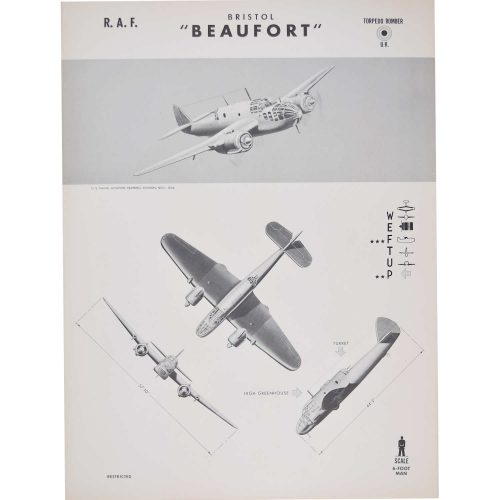
Bristol Beaufort Torpedo Bomber
US Naval Aviation Training Division Original aeroplane recognition poster (1942) 63 x 47 cm A particularly unusual style of aeroplane identification poster, owing to the very arty images. Most such posters rely on very plain silhouettes, this series - and we have several in this series; view them here - have a much more arty approach to the task with shading and an interesting angle view. The Bristol Beaufort (manufacturer designation Type 152) was a British twin-engined torpedo bomber designed by the Bristol Aeroplane Company, and developed from experience gained designing and building the earlier Blenheim light bomber. At least 1,180 Beauforts were built by Bristol and other British manufacturers. The Australian government''s Department of Aircraft Production (DAP) also manufactured variants of the Beaufort. These are often known collectively as the DAP Beaufort. More than 700 Australian-built Beauforts saw service with the Royal Australian Air Force in the South West Pacific theatre, where they were used until the end of the war. Beauforts first saw service with Royal Air Force Coastal Command and then the Royal Navy Fleet Air Arm from 1940. They were used as torpedo bombers, conventional bombers and mine-layers until 1942, when they were removed from active service and were then used as trainer aircraft until being declared obsolete in 1945. Beauforts also saw considerable action in the Mediterranean; Beaufort squadrons based in Egypt and on Malta helped interdict Axis shipping supplying Rommel's Deutsches Afrikakorps in North Africa. Although it was designed as a torpedo-bomber, the Beaufort was more often used as a medium day bomber. The Beaufort also flew more hours in training than on operational missions and more were lost through accidents and mechanical failures than were lost to enemy fire. The Beaufort was adapted as a long-range heavy fighter variant called the Beaufighter, which proved to be very successful and many Beaufort units eventually converted to the Beaufighter. Condition: good. If you’d like to know more, please email info@manningfineart.co.uk or call us on 07929 749056. -
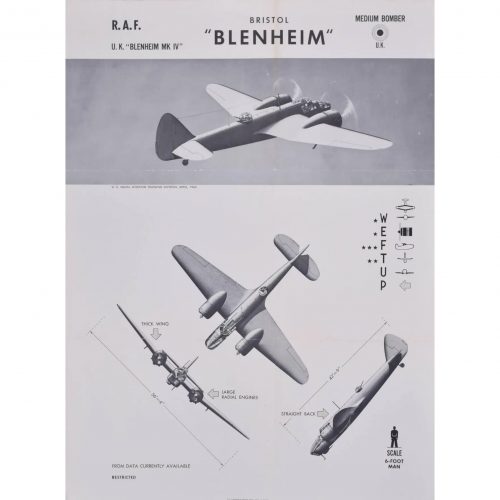
Royal Air Force Bristol Blenheim
US Naval Aviation Training Division Original aeroplane recognition poster (1942) 63 x 47 cm A particularly unusual style of aeroplane identification poster, owing to the very arty images. Most such posters rely on very plain silhouettes, this series - and we have several in this series; view them here - have a much more arty approach to the task with shading and an interesting angle view. The Bristol Blenheim is a British light bomber aircraft designed and built by the Bristol Aeroplane Company which was used extensively in the first two years of the Second World War. Condition: Generally very good, occasional handling marks or folds. If you’d like to know more, please email info@manningfineart.co.uk or call us on 07929 749056. -
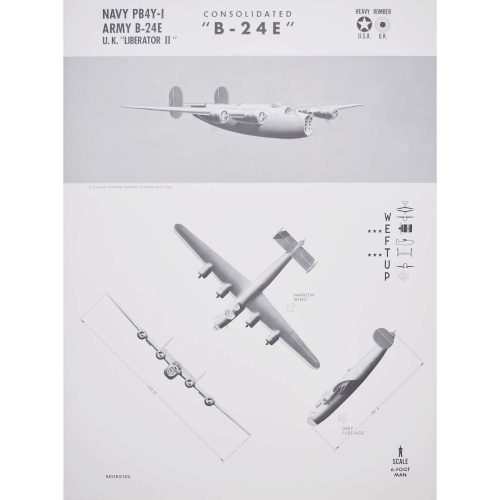
Navy and Army Consolidated Aircraft "B-24E" "Liberator II"
US Naval Aviation Training Division Original aeroplane recognition poster (1942) 63 x 47 cm A particularly unusual style of aeroplane identification poster, owing to the very arty images. Most such posters rely on very plain silhouettes, this series - and we have several in this series; view them here - have a much more arty approach to the task with shading and an interesting angle view. The Consolidated B-24 Liberator is an American heavy bomber, designed by Consolidated Aircraft of San Diego, California. Early RAF Liberators were the first aircraft to cross the Atlantic Ocean as a matter of routine. The B-24 was used extensively in World War II. It served in every branch of the American armed forces as well as several Allied air forces and navies, and was used in every theatre of war operations. In comparison with its contemporaries, the B-24 was relatively difficult to fly and had poor low-speed performance; it also had a lower ceiling and was less robust than the Boeing B-17 Flying Fortress. While aircrews tended to prefer the B-17, General Staff favoured the B-24 and procured it in huge numbers for a wide variety of roles. At approximately 18,500 units – including 8,685 manufactured by Ford Engine Company – it holds records as the world's most produced bomber, heavy bomber, multi-engine aircraft, and American military aircraft in history. Condition: Generally very good, occasional handling marks. If you’d like to know more, please email info@manningfineart.co.uk or call us on 07929 749056. -
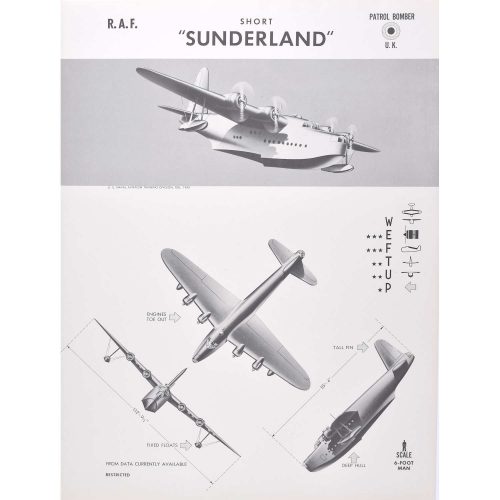
US Naval Aviation Training Division
Short Sunderland
Aeroplane identification poster, published 1942 63 x 47 cm A particularly unusual style of aeroplane identification poster, owing to the very arty images. Most such posters rely on very plain silhouettes, this series - and we have several in this series; view them here - have a much more arty approach to the task with shading and an interesting angle view. The Avro Lancaster is a British Second World War heavy bomber. It was designed and manufactured by Avro as a contemporary of the Handley Page Halifax, both bombers having been developed to the same specification, as well as the Short Stirling, all three aircraft being four-engined heavy bombers adopted by the Royal Air Force (RAF) during the same wartime era. The Short Sunderland was a British flying boat patrol bomber, developed and constructed by Short Brothers for the Royal Air Force (RAF). The aircraft took its service name from the town (latterly, city) and port of Sunderland in North East England. The Sunderland was one of the most powerful and widely used flying boats throughout the Second World War. In addition to the RAF, the type was operated by other Allied military air wings, including the Royal Australian Air Force (RAAF), Royal Canadian Air Force (RCAF), South African Air Force (SAAF), Royal New Zealand Air Force (RNZAF), French Navy, Norwegian Air Force, and the Portuguese Navy. During the conflict, the Sunderland was heavily involved in Allied efforts to counter the threat posed by German U-boats in the Battle of the Atlantic. On 17 July 1940, a RAAF Sunderland (of No. 10 Squadron) performed the type's first unassisted U-boat kill. The Sunderland also played a major role in the Mediterranean theatre, performing maritime reconnaissance flights and logistical support missions. During the evacuation of Crete, shortly after the German invasion of the island, several aircraft were used to transport troops. Numerous unarmed Sunderlands were also flown by civil operator British Overseas Airways Corporation (BOAC), traversing routes as far afield as the Pacific Ocean. Condition: generally very good, occasional handling marks. If you are interested, please email info@manningfineart.co.uk or call us on 07929 749056. -
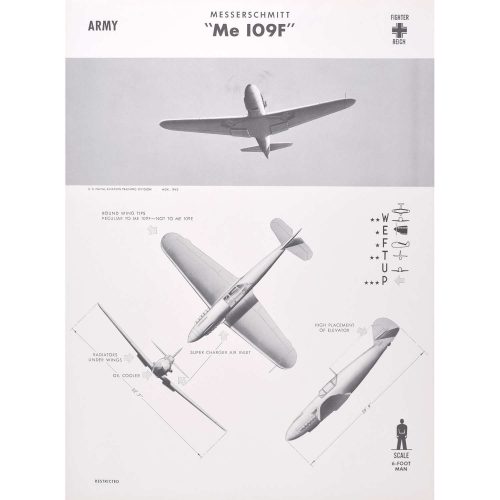
US Naval Aviation Training Division
Messerschmitt BF 109
Aeroplane identification poster, published 1942 63 x 47 cm A particularly unusual style of aeroplane identification poster, owing to the very arty images. Most such posters rely on very plain silhouettes, this series - and we have several in this series; view them here - have a much more arty approach to the task with shading and an interesting angle view. The Messerschmitt Bf 109 is a German World War II fighter aircraft that was, along with the Focke-Wulf Fw 190, the backbone of the Luftwaffe's fighter force. The Bf 109 first saw operational service in 1937 during the Spanish Civil War and was still in service at the dawn of the jet age at the end of World War II in 1945. It was one of the most advanced fighters when it first appeared, with an all-metal monocoque construction, a closed canopy, and retractable landing gear. It was powered by a liquid-cooled, inverted-V12 aero engine. It was called the Me 109 by Allied aircrew and some German aces, even though this was not the official German designation. It was designed by Willy Messerschmitt and Robert Lusser who worked at Bayerische Flugzeugwerke during the early to mid-1930s. It was conceived as an interceptor, although later models were developed to fulfil multiple tasks, serving as bomber escort, fighter-bomber, day-, night-, all-weather fighter, ground-attack aircraft, and reconnaissance aircraft. It was supplied to several states during World War II and served with several countries for many years after the war. The Bf 109 is the most produced fighter aircraft in history, with a total of 33,984 airframes produced from 1936 to April 1945. Some of the Bf 109 production took place in Nazi concentration camps through slave labor. The Bf 109 was flown by the three top-scoring fighter aces of all time, who claimed 928 victories among them while flying with Jagdgeschwader 52, mainly on the Eastern Front. The highest-scoring, Erich Hartmann, was credited with 352 victories. The aircraft was also flown by Hans-Joachim Marseille, the highest-scoring ace in the North African Campaign who shot down 158 enemy aircraft. It was also flown by many aces from other countries fighting with Germany, notably the Finn Ilmari Juutilainen, the highest-scoring non-German ace. Pilots from Italy, Romania, Croatia, Bulgaria, and Hungary also flew the Bf 109. Through constant development, the Bf 109 remained competitive with the latest Allied fighter aircraft until the end of the war. Condition: generally very good. If you are interested, please email info@manningfineart.co.uk or call us on 07929 749056. -
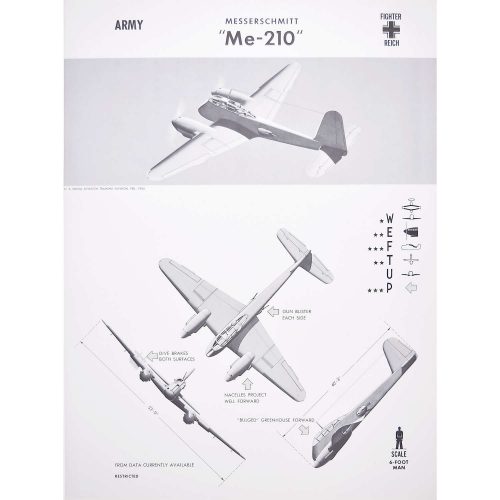
US Naval Aviation Training Division
Messerschmitt BF 210
Aeroplane identification poster, published 1942 63 x 47 cm A particularly unusual style of aeroplane identification poster, owing to the very arty images. Most such posters rely on very plain silhouettes, this series - and we have several in this series; view them here - have a much more arty approach to the task with shading and an interesting angle view. The Messerschmitt Me 210 was a two-seater German heavy fighter and ground-attack aircraft of World War II. Initial development of the 210 was started by Messerschmitt in 1938 at the request of the Luftwaffe. Condition: generally very good. If you are interested, please email info@manningfineart.co.uk or call us on 07929 749056. -
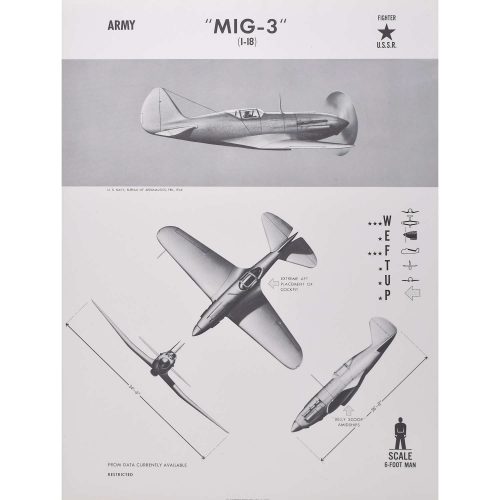
US Naval Aviation Training Division
MIG-3
Aeroplane identification poster, published 1942 63 x 47 cm A particularly unusual style of aeroplane identification poster, owing to the very arty images. Most such posters rely on very plain silhouettes, this series - and we have several in this series; view them here - have a much more arty approach to the task with shading and an interesting angle view. The Mikoyan-Gurevich MIG-3 was a Soviet fighter and interceptor aircraft used during World War II. It was a development of the MIG-1 by the Experimental Design Department of Factory No. 1 to remedy problems found during the MIG-1's development and operations. On 22 June 1941, at the beginning of Operation Barbarossa, some 981 MIG-3s were in service with the Soviet Air Forces, the Soviet Air Defence Forces, and Soviet Naval Aviation. The MIG-3 was difficult to fly in peacetime and much more so in combat. Originally designed as a high-altitude fighter-interceptor, combat over the Eastern Front was generally at lower altitudes, where it was inferior to the German Messerschmitt Bf 109 (a poster of which is available in our storefront) as well as most of its Soviet contemporaries. It was also pressed into service as a fighter-bomber during the autumn of 1941 but it was equally unsuited for this. The losses suffered in combat were very high, in percentage the highest among all the VVS fighters, with 1,432 shot down. Condition: generally very good. If you are interested, please email info@manningfineart.co.uk or call us on 07929 749056. -
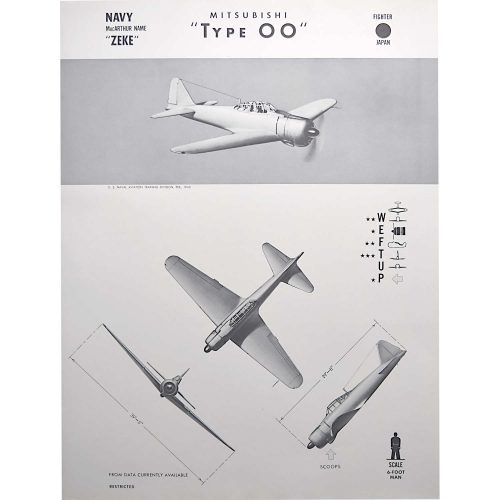
US Naval Aviation Training Division
MacArthur name "Zeke" or Zero Mitsubishi "Type 00" - Japanese fighter plane
Aeroplane identification poster, published 1943 63 x 47 cm A particularly unusual style of aeroplane identification poster, owing to the very arty images. Most such posters rely on very plain silhouettes, this series - and we have several in this series; view them here - have a much more arty approach to the task with shading and an interesting angle view. The Mitsubishi A6M "Zero" was a long-range carrier-based fighter aircraft formerly manufactured by Mitsubishi Aircraft Company, a part of Mitsubishi Heavy Industries, and was operated by the Imperial Japanese Navy from 1940 to 1945. The official Allied reporting name was "Zeke", although the name "Zero" (from Type 0) was used colloquially by the Allies as well. The Zero was considered to have been the most capable carrier-based fighter in the world when it was introduced early in World War II, combining excellent manoeuvrability and very long range. The Imperial Japanese Navy Air Service (IJNAS) also frequently used it as a land-based fighter. In early combat operations, the Zero gained a reputation as a dogfighter, achieving an outstanding kill ratio of 12 to 1, but by mid-1942 a combination of new tactics and the introduction of better equipment enabled Allied pilots to engage the Zero on generally equal terms. The Zero continued to serve in a front-line role until the end of the war in the Pacific; during the final phases, it was also adapted for use in kamikaze operations. Japan produced more Zeros than any other model of combat aircraft during the Second World War. Condition: generally very good. If you are interested, please email info@manningfineart.co.uk or call us on 07929 749056. -
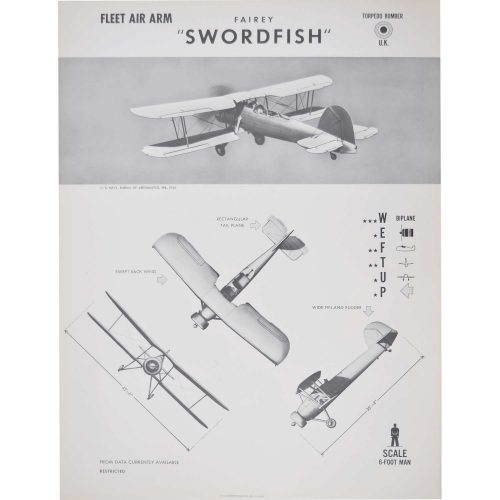
Fairey Swordfish
Aeroplane identification poster, published 1942 63 x 47 cm A particularly unusual style of aeroplane identification poster, owing to the very arty images. Most such posters rely on very plain silhouettes, this series - and we have several in this series; view them here - have a much more arty approach to the task with shading and an interesting angle view. The Fairey Swordfish is a biplane torpedo bomber designed by the Fairey Aviation Company. Originating in the early 1930s, the Swordfish, nicknamed "Stringbag", was operated by the Fleet Air Arm of the Royal Navy, it was also used by the Royal Air Force (RAF), as well as several overseas operators, including the Royal Canadian Air Force (RCAF) and the Royal Netherlands Navy. It was initially operated primarily as a fleet attack aircraft. During its later years, the Swordfish became increasingly used as an anti-submarine and training platform. The type was in frontline service throughout the Second World War. Despite being obsolete by 1939, the Swordfish achieved some spectacular successes during the war. Notable events included sinking one battleship and damaging two others of the Regia Marina (the Italian Navy) during the Battle of Taranto, and the famous attack on the Bismarck, which contributed to her eventual demise. By the end of the war, the Swordfish held the distinction of having caused the destruction of a greater tonnage of Axis shipping than any other Allied aircraft. The Swordfish remained in front-line service until V-E Day, having outlived multiple aircraft that had been intended to replace it in service. Condition: generally very good. If you are interested, please email info@manningfineart.co.uk or call us on 07929 749056. -
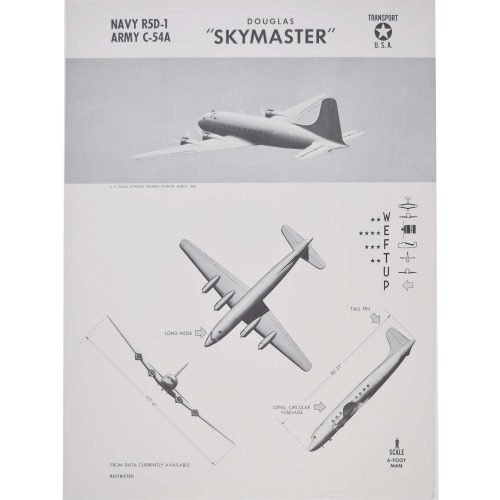
1942 Navy R5D-1 Army C-54A Douglas "Skymaster"
Aeroplane identification poster, published 1942 63 x 47 cm A particularly unusual style of aeroplane identification poster, owing to the very arty images. Most such posters rely on very plain silhouettes, this series - and we have several in this series; view them here - have a much more arty approach to the task with shading and an interesting angle view. The Douglas Skymaster was a four-engine transport aircraft used by the United States Army Air Forces in World War II and the Korean War. Like the Douglas C-47 Skytrain (the Skytrain poster from the same series is also available in our storefront), the Skymaster was derived from a civilian airliner, the Douglas DC-4. To meet military requirements, the first civil production aircraft had four additional auxiliary fuel tanks in the main cabin which reduced the passenger seats to 26. The following batch of aircraft, designated C-54A, were built with a stronger floor and a cargo door with a hoist and winch. The first C-54A was delivered in February 1943. Skymasters used by the United States Navy were designated Douglas R5D. As well as being used for cargo transport, the C-54 also carried presidents, prime ministers, and military staff. Dozens of variants of the C-54 were employed in a wide variety of non-combat roles such as air-sea rescue, scientific and military research, and missile tracking and recovery. During the Berlin Airlift it hauled coal and food supplies to West Berlin. After the Korean War it continued to be used for military and civilian uses by more than 30 countries. Condition: generally very good. If you are interested, please email info@manningfineart.co.uk or call us on 07929 749056. -
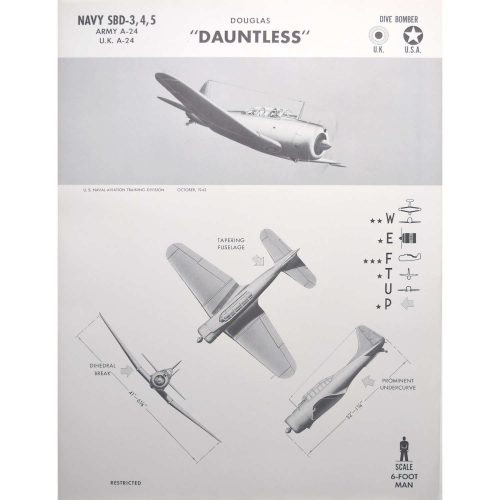
Navy SBD-3, 4, 5, Army A-24 Douglas "Dauntless"
Aeroplane identification poster, published 1942 63 x 47 cm A particularly unusual style of aeroplane identification poster, owing to the very arty images. Most such posters rely on very plain silhouettes, this series - and we have several in this series; view them here - have a much more arty approach to the task with shading and an interesting angle view. The Douglas SBD Dauntless was a World War II American naval scout plane and dive bomber that was manufactured by Douglas Aircraft from 1940 through 1944. The SBD ("Scout Bomber Douglas") was the United States Navy''s main carrier-based scout/dive bomber from mid-1940 through mid-1944. The SBD was also flown by the United States Marine Corps, both from land air bases and aircraft carriers. The SBD is best remembered as the bomber that delivered the fatal blows to the Japanese carriers at the Battle of Midway in June 1942. During Midway, four squadrons of Dauntless dive bombers attacked and sank or fatally damaged all four Japanese fleet carriers present, disabling three of them in the span of just six minutes (Akagi, Kaga, and Sōryū) and, later in the day, Hiryū. During its combat service, the SBD proved to be an excellent naval scout plane and dive bomber. It possessed long range, good handling characteristics, manoeuvrability, potent bomb load, great diving characteristics from the perforated dive brakes, good defensive armament, and ruggedness. Condition: generally very good. If you are interested, please email info@manningfineart.co.uk or call us on 07929 749056. -
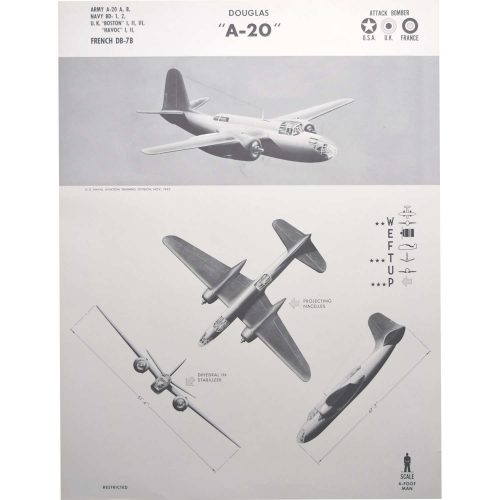
Army A-20 A, B, Navy BD- 1, 2, UK "Boston" I, II, III, "Havoc" I, II, French DB-7B Douglas "A-20"
Aeroplane identification poster, published 1942 63 x 47 cm A particularly unusual style of aeroplane identification poster, owing to the very arty images. Most such posters rely on very plain silhouettes, this series - and we have several in this series; view them here - have a much more arty approach to the task with shading and an interesting angle view. The Douglas A-20 was a medium bomber, attack aircraft, night intruder, night fighter, and reconnaissance aircraft of World War II. Designed to meet an Army Air Corps requirement for a bomber, it was ordered by France for their air force before the USAAC decided it would also meet their requirements. French DB-7s were the first to see combat. The A-20 served with several Allied air forces, principally the United States Army Air Forces (USAAF), the Soviet Air Forces (VVS), Soviet Naval Aviation (AVMF), and the Royal Air Force (RAF) of the United Kingdom. A total of 7,478 aircraft were built, of which more than a third served with Soviet units. It was also used by the air forces of Australia, South Africa, France, and the Netherlands during the war. Condition: generally very good. If you are interested, please email info@manningfineart.co.uk or call us on 07929 749056. -
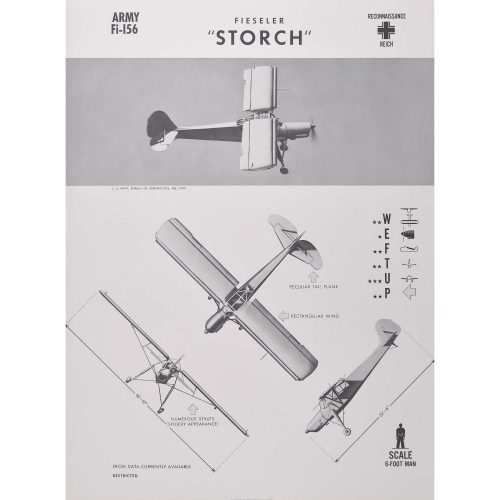
Army Fi-156 Fieseler "Storch"
Aeroplane identification poster, published 1944 63 x 47 cm A particularly unusual style of aeroplane identification poster, owing to the very arty images. Most such posters rely on very plain silhouettes, this series - and we have several in this series; view them here - have a much more arty approach to the task with shading and an interesting angle view. The Fieseler Fi 156 Storch, meaning "stork", was a small German liaison aircraft built by Fieseler before and during World War II. It was notable for its excellent short-takeoff-and-landing performance and low stall speed of 31 mph.The Douglas Skymaster was a four-engine transport aircraft used by the United States Army Air Forces in World War II and the Korean War. Like the Douglas C-47 Skytrain (the Skytrain poster from the same series is also available in our storefront), the Skymaster was derived from a civilian airliner, the Douglas DC-4. The Storch was deployed in all European and North African theatres of World War II. In addition to its liaison function, a number were used to fly a battalion of Infantry Regiment Grossdeutschland behind enemy lines during the invasion of Belgium. In 1943, the Storch played a role in Operation Eiche, the rescue of deposed Italian dictator Benito Mussolini from a boulder-strewn mountain-top near the Gran Sasso. Even though the mountain was surrounded by Italian troops, German commando Otto Skorzeny and 90 paratroopers used gliders to land on the peak and quickly captured it. However, the problem of how to get back off remained. A Focke-Achgelis Fa 223 helicopter was sent, but it broke down en route. Instead, pilot Heinrich Gerlach flew over in a Storch. After Mussolini and Skorzeny had boarded the aircraft, the Storch took off to 250 ft, even though the aircraft was overloaded. A Storch was the last aircraft shot down by the Allies on the Western Front. Condition: generally very good. If you are interested, please email info@manningfineart.co.uk or call us on 07929 749056. -
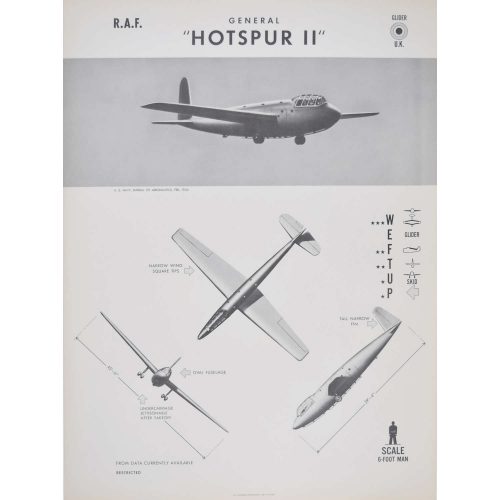
1942 RAF General Hotspur II
Aeroplane identification poster, published 1942 63 x 47 cm A particularly unusual style of aeroplane identification poster, owing to the very arty images. Most such posters rely on very plain silhouettes, this series - and we have several in this series; view them here - have a much more arty approach to the task with shading and an interesting angle view. A particularly unusual style of aeroplane recognition poster, owing to the very arty images. Most such posters rely on very plain silhouettes, this series - and we have several in this series - have a much more arty approach to the task with shading and an interesting angle view. The General Aircraft GAL.48 Hotspur was a military glider designed and built by the British company General Aircraft Ltd during World War II. When the British airborne establishment was formed in 1940 by order of Prime Minister Winston Churchill, it was decided that gliders would be used to transport airborne troops into battle. General Aircraft Ltd were given a contract by the Ministry of Aircraft Production in June 1940 to design and produce an initial glider for use by the airborne establishment, which resulted in the Hotspur. Conceived as an "assault" glider which necessitated a compact design and no more than eight troops carried, tactical philosophy soon favoured larger numbers of troops being sent into battle aboard gliders. Due to this, the Hotspur was mainly relegated to training where it did excel and it became the basic trainer for the glider schools that were formed. The Hotspur was named after Sir Henry Percy, a significant captain during the Anglo-Scottish wars who was also known as "Hotspur". A Hotspur Mark II (HH268) replica is on display at the Museum of Army Flying in Hampshire, England. The front fuselage of a Hotspur was preserved at the Parachute Regiment And Airborne Forces Museum in Aldershot prior to the museum''s 2007 closing, in anticipation of a move to the Imperial War Museum Duxford. Condition: generally very good. If you are interested, please email info@manningfineart.co.uk or call us on 07929 749056. -
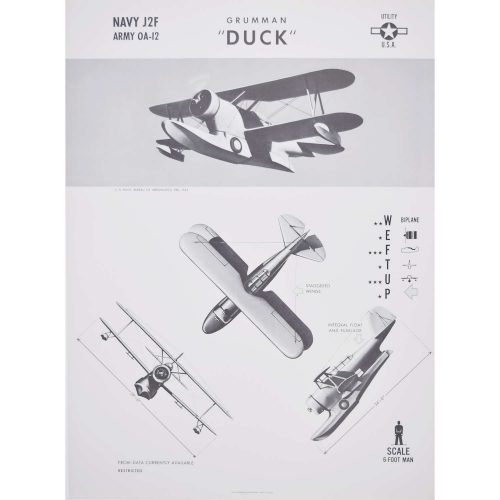
Navy and Army Grumman "Duck"
Aeroplane identification poster, published 1942 63 x 47 cm A particularly unusual style of aeroplane identification poster, owing to the very arty images. Most such posters rely on very plain silhouettes, this series - and we have several in this series; view them here - have a much more arty approach to the task with shading and an interesting angle view. The Grumman J2F Duck was an American single-engine amphibious biplane. It was used by each major branch of the U.S. armed forces from the mid-1930s until just after World War II, primarily for utility and air-sea rescue duties. It was also used by the Argentine Navy, who took delivery of their first J2F in 1937. Apart from general utility and light transport duties, its missions included mapping, reconnaissance, anti-submarine patrol, air-sea rescue work, photographic surveys, and target tug. Condition: generally very good. If you are interested, please email info@manningfineart.co.uk or call us on 07929 749056. -
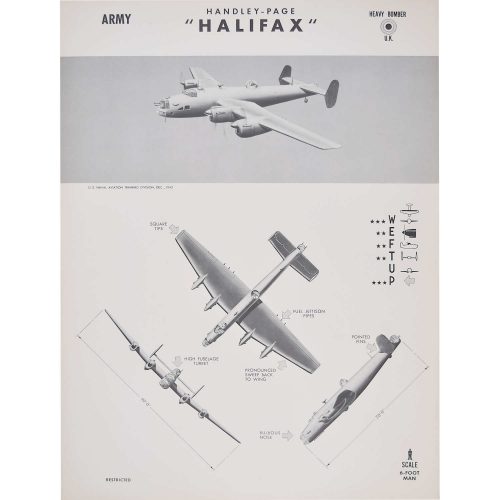
Handley-Page "Halifax"
Aeroplane identification poster, published 1942 63 x 47 cm A particularly unusual style of aeroplane identification poster, owing to the very arty images. Most such posters rely on very plain silhouettes, this series - and we have several in this series; view them here - have a much more arty approach to the task with shading and an interesting angle view. The Halifax bomber was a twin-engined bomber that entered service with the RAF in 1940. Viewed by Arthur ''Bomber'' Harris as inferior to the Lancaster, on account of its smaller payload, the crews preferred it. 1,833 aircraft were lost in service with Bomber Command, across a total of 82,733 operations. Only three survive, one at the Yorkshire Air Museum in Elvington (based on a fuselage that had been in use at a chicken farm following a crash near Stornoway), one at the National Air Force Museum of Canada (which was discovered in 1991 in Norway and subsequently restored), and one at the RAF Museum in London (that crash landed in Norway following an attack on the German battleship Tirpitz; rediscovered in 1971, it has been left unrestored). Condition: generally very good. If you are interested, please email info@manningfineart.co.uk or call us on 07929 749056. -
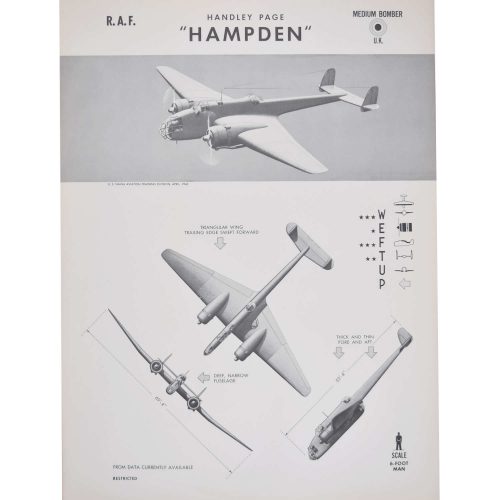
Royal Air Force Handley Page "Hampden" Bomber
Aeroplane identification poster, published 1943 63 x 47 cm A particularly unusual style of aeroplane identification poster, owing to the very arty images. Most such posters rely on very plain silhouettes, this series - and we have several in this series; view them here - have a much more arty approach to the task with shading and an interesting angle view. The Handley Page HP.52 Hampden is a British twin-engine medium bomber that was operated by the Royal Air Force (RAF). It was part of the trio of large twin-engine bombers procured for the RAF, joining the Armstrong Whitworth Whitley and Vickers Wellington. The Hampden was powered by Bristol Pegasus radial engines but a variant known as the Handley Page Hereford had in-line Napier Daggers. The Hampden served in the early stages of the Second World War, bearing the brunt of the early bombing war over Europe, taking part in the first night raid on Berlin and the first 1,000-bomber raid on Cologne. When it became obsolete, after a period of mainly operating at night, it was retired from RAF Bomber Command service in late 1942. By 1943, the rest of the trio were being superseded by the larger four-engined heavy bombers such as the Avro Lancaster. Condition: generally very good. If you are interested, please email info@manningfineart.co.uk or call us on 07929 749056. -
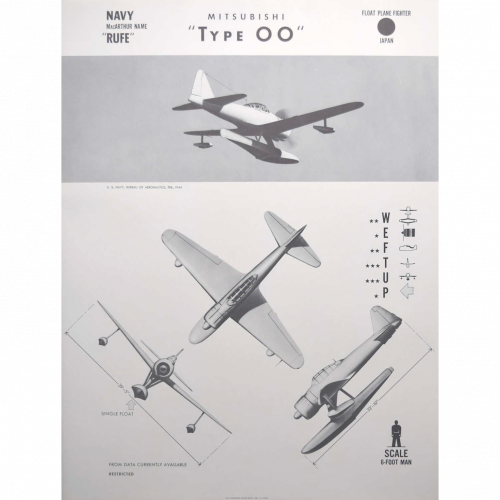
"Rufe" Mitsubishi "Type OO"
Aeroplane identification poster, published 1942 63 x 47 cm A particularly unusual style of aeroplane identification poster, owing to the very arty images. Most such posters rely on very plain silhouettes, this series - and we have several in this series; view them here - have a much more arty approach to the task with shading and an interesting angle view. This Japanese floatplane, known to the Allies as a "Rufe", was developed from the Mitsubishi A6M Type 0 - the famous ''Zero'' figher, mainly to support amphibious operations and defend remote bases. It was based on the A6M-2 Model 11 fuselage, with a modified tail and added floats. A total of 327 were built, including the original prototype. The aircraft was deployed in 1942 and was only used in operations taking place in the Aleutians and Solomon Islands. Such seaplanes were effective in harassing American patrol torpedo boats at night. They could also drop flares to illuminate the American boats which were vulnerable to destroyer gunfire, and depended on cover of darkness. Condition: generally very good. If you are interested, please email info@manningfineart.co.uk or call us on 07929 749056. -
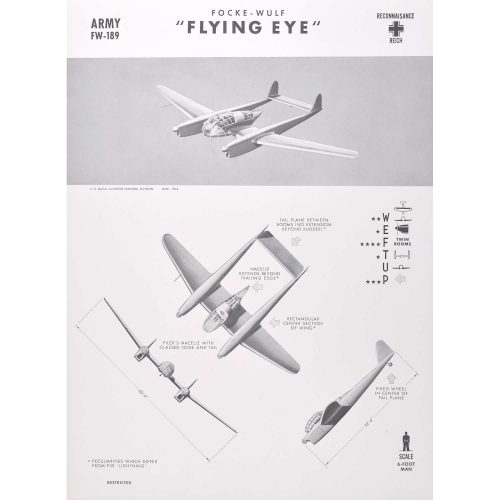
Army FW-189 "Flying Eye"
Aeroplane identification poster, published 1942 63 x 47 cm A particularly unusual style of aeroplane identification poster, owing to the very arty images. Most such posters rely on very plain silhouettes, this series - and we have several in this series; view them here - have a much more arty approach to the task with shading and an interesting angle view. The Focke-Wulf Fw 189 Uhu ("Eagle Owl") was a German twin-engine, twin-boom, three-seat tactical reconnaissance and army cooperation aircraft. It first flew in 1938, entered service in 1940 and was produced until mid-1944. It was nicknamed the “Flying Eye.” Patrolling the vast flatlands of Ukraine and Belarus, the Flying Eye was used extensively on the Eastern Front with great success. It was nicknamed "Rama" ("frame") by Soviet forces, in reference to its distinctive tailboom and stabiliser shapes, which gave it its characteristic quadrangular appearance. Despite its low speed, the Fw 189's manoeuvrability made it a difficult target for attacking Soviet fighters. When attacked, the Flying Eye was often able to out-turn enemy fighters by simply flying in a tight circle. Condition: generally very good. If you are interested, please email info@manningfineart.co.uk or call us on 07929 749056.

